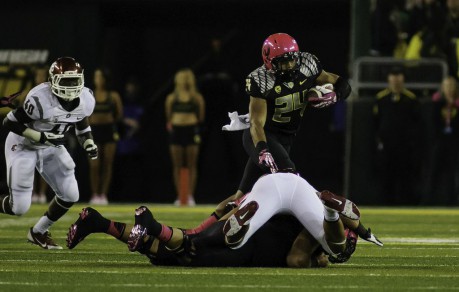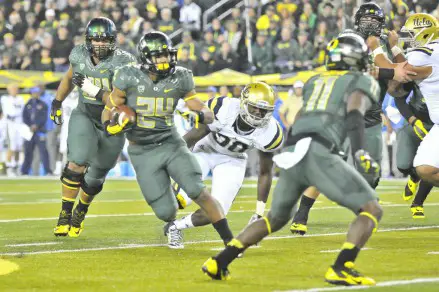The Oregon football program has an extremely impressive resume when it comes to running backs, especially over the past 10 or 15 years. Among the greats that have come out of the Duck backfield are Maurice Morris, Jonathan Stewart, LeGarrette Blount, LaMichael James and Kenjon Barner.
However, there is a new Duck in town who has the potential to be the greatest on the list, after all is said and done.
Of those listed above, Stewart is the only one who was considered a truly elite recruit. (There was, of course, also De’Anthony Thomas, but he was never limited to a running back role.) That is, until Thomas Tyner, an in-state star on both the gridiron and track, committed to Oregon. Considered one of the best running back prospects in the nation, Tyner gave the 2013 recruiting class a huge boost.
The stud from Aloha, Oregon, even rushed for 10 touchdowns in one high school game during his senior season.
Tyner lives up to the high expectations that come with a five-star rating, as a true freshman – averaging 6.18 yards per carry for 711 rushing yards and nine touchdowns. Comparing his first year to former Duck greats and other running backs around the nation, it becomes clear that Tyner is something special.
For starters, Tyner ranked third among freshmen running backs in AQ conferences with his ypc average, behind only Corey Clement of Wisconsin and Baylor’s Shock Linwood. Tyner, however, had 164 more rushing yards than Clement, and one more rushing score than Linwood.
Of the former Oregon running backs, Tyner is probably most comparable to Stewart, not only in terms of hype, but also style.
Oregon’s spread-out system allows for smaller backs such as James and Barner to thrive, even between the tackles. Still, to have a balanced back with both speed and size is invaluable to any team. Stewart had great wheels, but also weighed in at 230 pounds, making him very hard to take down. Tyner is not quite as heavy, but the former track star is pushing 220 pounds heading into the 2014 season.
Looking at Stewart’s freshman season, he rushed for only 188 yards and 6 touchdowns. While Tyner’s statistics, on the surface, far exceeded those of Stewart’s first campaign, they become even more impressive when you consider the fact that he had to compete for carries with both Byron Marshall and Thomas, two of the conference’s best offensive weapons.
With three 1,500-yard seasons in the books, it seems hard to believe that anyone would be able to reach James’ school record of 5,082 rushing yards. Nonetheless, should Tyner cement himself as the Ducks’ primary back over a healthy four years, he certainly has the potential.
During his redshirt freshman season, James was thrust into the spotlight after a season-long suspension of Blount in Week 1. He proceeded to carry the team on his back with 1,546 yards on the ground. That was in 2009 when he was mainly only competing for carries with fellow freshman Barner.
Interestingly enough, James’ 230 carries in 2009 were exactly twice that of Tyner’s 115 in 2013. If Tyner’s numbers were extrapolated to meet his predecessor’s workload, his slightly lower yards-per-carry average would put him at 1,422 yards on the ground and 18 touchdowns (four more scores than James had in 2009).
Like James, Tyner is also a threat in the passing game, catching 14 passes in 2013. That is the kind of balance that NFL scouts love to see, especially if he can demonstrate his ability to pass block.
At this rate, it is plausible to think that Tyner may end up leaving Oregon for the NFL after his junior year, especially considering the fact that professional running backs are reaching their primes at an increasingly earlier stage in their careers.
However, should he stay through the next three years, he would need to average 1,457 yards per season to match James’ record. To put it into perspective, that number is quite close to the total posted by James in 2009, and went on to eclipse convincingly in 2010 and 2011.
An early departure would mean that the sophomore-to-be would need 2,185 yards per season — which are closer to numbers you see in video games than in real life — to get the record. Still, it would not be entirely unprecedented, as Boston College back Andre Williams ran for 2,177 yards with a yards-per-carry average of 6.13 (.05 fewer yards per carry than Tyner).
All numbers aside, Tyner showed that he will be the next great back to come to Eugene. His speed, size and versatility make him a balanced threat that could keep any defense up at night and get any NFL scout excited.
Look for Tyner to push 1,000 rushing yards along with teammate Marshall out of the backfield in 2014, and don’t be surprised if he emerges as one of the biggest breakout stars in college football this year as well.
Top Photo by Craig Strobeck
Related Articles:
Chip Kelly Update: Everything's Good Again ...
Chip Kelly Update: Wailing and Gnashing of Teeth
Shock and Awe -- The Oregon Ducks' Football Hangover Effect
Despite Lopsided Score, Georgia State "Never Stopped Believing"
Hope Springs Eternal for Ducks
Incompetent Pac-12 Officials: How Do You Miss ALL of THIS?
Joey Holland graduated from the University of Oregon in 2013, majoring in History. He played several sports in high school, though football remains his passion. He has yet to miss a single Oregon Ducks home football game during his time in Eugene. Joey has written previously for Bleacher Report and Football Nation.
Joey welcomes your feedback.



